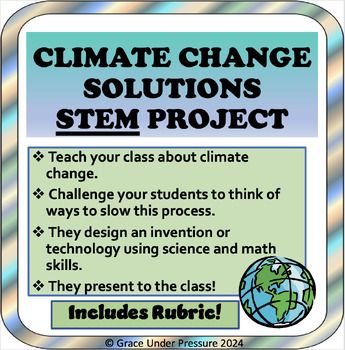Climate Change Solutions STEM Project with Rubric: Middle School Science
- PDF
- Easel Activity
Also included in
- Here are four middle school or upper elementary STEM (science, technology, engineering, and math) projects that will keep your students engaged all year long as they learn about the scientific method, climate change, extreme environments, and a topic of their choosing. 4 Engaging Student-Directed PrPrice $9.50Original Price $14.50Save $5.00
- Help your middle school students learn about climate change and earth science through two unique projects:1) CLIMATE CHANGE SOLUTIONS: Students learn about climate change, do research, use math skills, and think creatively to design a technology to help reduce or capture greenhouse gases. They creatPrice $4.50Original Price $6.00Save $1.50
Description
In this engaging STEM project, you will challenge your students in grades 6-9 to think of ways to slow or reverse climate change. They will work in pairs or small groups to design an invention or technology that can help put the earth’s atmospheric carbon dioxide back in balance. They will use research skills, science knowledge, design ideas, and math calculations to convey their learning. Then, they will present their idea to the class!
1) First, teach your students about climate change and the carbon cycle. Show some videos from this website:
https://www.plt.org/educator-tips/videos-climate-change-middle-school
And download this climate change FREEBIE from my store:
2) Have your students take notes, summarize climate change in their own words, and draw a diagram of what causes climate change (on the included worksheet).
3) Then work as a class to brainstorm ways to interrupt the human-caused climate change process. There are many categories that ideas could fit into: reduce greenhouse gases from human activities, increase photosynthesis to absorb more CO2, reflect more of the sun's rays away from earth, capture and store excess carbon emissions, use principles of chemistry to turn excess CO2 into something else. Within each of these categories there are countless creative ideas waiting to be discovered!
4) Next, students split into pairs or groups and work to research one of the unique ideas. They have to explain their specific idea, how it would work, what materials they would need, how much of them would be required, where it could occur, and explicitly explain how this idea would help to reduce climate change.
5) Students can present their ideas using a poster, slide show, pamphlet, video, model, etc.
6) This project also includes a rubric for easy assessment.
What's Included:
7 Page PDF: Ready to Print and Go!
- 2 Pages of teacher instructions and ideas: you don't need to be an expert to use this project; everything is ready for you.
- Student Worksheet to learn about climate change
- Student Mindmap to record ideas during the class brainstorm
- 2 Pages of Student Graphic Organizers to help guide their plan
- Rubric








